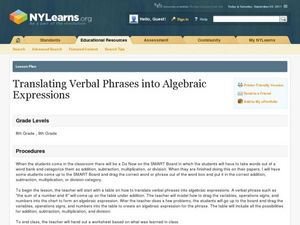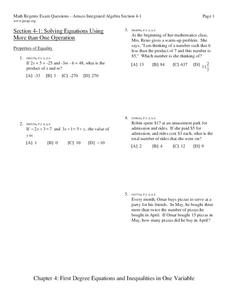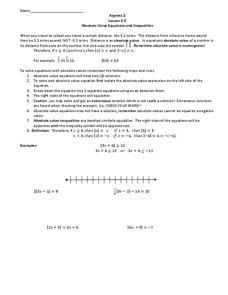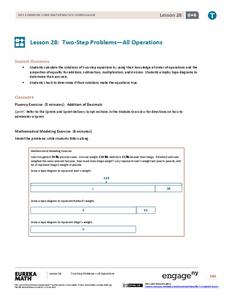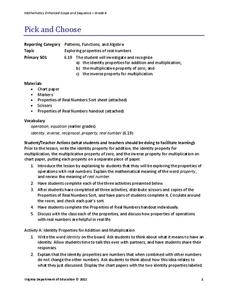Curated OER
Translating Verbal Phrases into Algebraic Expressions
Students rewrite word problems using algebraic symbols. In this algebra lesson plan, students graph linear equations after they rewrite the equation using algebra. They relate math to the real world.
Curated OER
Solving One Step Equations Using Algebra Tiles
Students solve linear equations. In this algebra lesson, students solve equations using addition, subtraction, division and multiplication. They evaluate and simplify functions.
Curated OER
Addition to Solve System of Linear Equations
In this algebra worksheet, students solve system systems of equation. They use addition to solve the problems. There are 6 questions with an answer key.
Curated OER
Linear Systems: Graphical Interpretation of Vectors and Linear Systems
In this interpretation of vectors and linear systems activity, students describe the geometric appearance of two vectors. They add the two vectors and sketch the sum as well as the vectors to determine the commutativity of vector...
Curated OER
Solving Equations
In this Algebra II worksheet, 11th graders use the properties of equality to solve multi-step equations in one variable. The tow page worksheet contains explanation, guided examples, and fifteen practice problems. Answers are...
Curated OER
Solving Equations Using More than One Operation
In this algebra worksheet, students solve equations using addition, subtraction, multiplication and division. They solve word problems using equations. There are 5 questions with an answer key.
Curated OER
Absolute Value Equations and Inequalities
In this Algebra II worksheet, 11th graders solve and graph the solutions to absolute value equations and inequalities. The two page worksheet provides explanation and examples in addition to sixteen practice questions. Answers are...
Curated OER
Solutions to Equations with Variables on Both Sides
Students solve equations with variables on both sides. In this algebra lesson, students solve equations using addition, subtraction, multiplication and division. They graph their solution on a coordinate plane.
Curated OER
Investigating Linear Equations Using Graphing Calculator
Learners investigate linear equations using the Ti-Calculator. In this algebra lesson, students graph lines and identify the different quadrants on a coordinate plane. They identify ordered pairs used to plot lines.
Curated OER
Solving Equations
In this Algebra I instructional activity, 9th graders solve one-step equations using addition and subtraction. The one page instructional activity contains ten problems. Answers are provided.
Curated OER
Variables and Expressions
In this variables and expressions worksheet, students solve and complete 20 different problems that include various types of expressions. First, they write a variable expression of each given algebraic expression. Then, students write an...
Curated OER
Expressions
In this expressions worksheet, students solve and complete 16 different problems related to various expressions. First, they define each of the listed terms and know each given property. Then, students state the order of operations and...
Curated OER
Writing Number Sentences
Learners practice writing number sentences. After reading real world problems, they describe the same situation by writing a number sentence. Students use algebra tiles, or counters, to demonstrate the use zero pairs in solving...
Curated OER
Circles
Young scholars graph circles. In this graphing lesson students write equations for circles. Young scholars solve equations for circles and graph the results.
Curated OER
Linear Systems: Graphical Interpretation of Vectors
In this graphical interpretation of vectors activity, students execute operations of addition and multiplication by a scalar. They sketch results and determine the commutativity of vector addition. This three-page activity contains...
Inside Mathematics
Magic Squares
Prompt scholars to complete a magic square using only variables. Then they can attempt to solve a numerical magic square using algebra.
Inside Mathematics
Number Towers
Number towers use addition or multiplication to ensure each level is equal. While this is common in factoring, it is often not used with algebraic equations. Solving these six questions relies on problem solving skills and being able to...
Curated OER
Y-Intercept and Slope Intercept Form
Alegebra amateurs identify the slope and the y-intercept given a linear equation in slope-intercept form by correctly completing some in class problems. They write the linear equation in slope-intercept form that corresponds to the given...
Virginia Department of Education
Properties of Operations
Explore the definitions of algebraic properties through a hands-on activity. Individuals cut and paste examples and match them to the correct properties. After examining the provided examples, pupils create examples of their own.
Curated OER
Math Games for Skills and Concepts
A 27-page packet full of math games and activities builds on algebra, measurement, geometry, fractional, and graphing skills. Young mathematicians participate in math games collaboratively, promoting teamwork and skills practice.
Curated OER
Combining Like Terms
In this worksheet, algebra learners solve and complete 20 different equations that include combining like terms. First, they identify and define like terms and how they can be combined in solving an equation. Then, students combine like...
EngageNY
Two-Step Problems—All Operations
Step 1: Use the resource. Step 2: Watch your class become experts in solving two-step problems. Scholars learn to solve two-step word problems in context. They use tape diagrams and algebraic techniques to break the problem into two,...
EngageNY
Replacing Letters with Numbers II
Teach about properties properly. Individuals investigate the commutative and identity properties for both addition and multiplication. They see that the properties hold true for all values by using substitution to test out several examples.
Virginia Department of Education
Pick and Choose
Properly teach properties with three activities that allow learners to investigate properties of real numbers. The resource covers the identity properties for addition and multiplication, the inverse property for multiplication, and the...


